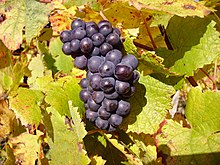| Pinot noir | |
|---|---|
| Grape (Vitis) | |
 Pinot noir grapes in Bué, Centre-Val de Loire, France | |
| Color of berry skin | Black |
| Also called | Blauburgunder, Spätburgunder, Rulandské modré, Pinot nero, other synonyms |
| Notable regions |
|
| Notable wines | Gevrey-Chambertin, Nuits-Saint-Georges |
| Ideal soil | Chalky clay |
| VIVC number | 9279 |
| Wine characteristics | |
| General | Light tannins |
| Cool climate | Cabbage, wet leaves |
| Medium climate | Strawberry, raspberry, cherry, mushroom, meaty |

Pinot noir (French: [pino nwaʁ] ), also known as Pinot nero, is a red-wine grape variety of the species Vitis vinifera. The name also refers to wines created predominantly from Pinot noir grapes. The name is derived from the French words for pine and black. The word pine alludes to the grape variety having tightly clustered, pinecone—shaped bunches of fruit.[1]
Pinot noir is grown around the world, mostly in cooler climates, and the variety is chiefly associated with the Burgundy region of France.[2] Pinot noir is now used to make red wines around the world, as well as champagne, sparkling white wines such as the Italian Franciacorta, and English sparkling wines. Regions that have gained a reputation for red Pinot noir wines include the Willamette Valley of Oregon; the Carneros, Central Coast, Sonoma Coast, and Russian River AVAs of California; the Elgin and Walker Bay wine regions of South Africa; the Mornington Peninsula, Adelaide Hills, Great Southern, Tasmania, and Yarra Valley in Australia; and the Central Otago, Martinborough, and Marlborough wine regions of New Zealand. Pinot noir is the most planted varietal (38%) used in sparkling wine production in Champagne and other wine regions.[3]
Pinot noir is a difficult variety to cultivate and transform into wine.[4] The grape's tendency to produce tightly packed clusters makes it susceptible to several viticultural hazards involving rot that require diligent canopy management.
The thin skins and low levels of phenolic compounds lend pinot to producing mostly lightly colored, medium-bodied and low-tannin wines that can often go through phases of uneven and unpredictable aging. When young, wines made from Pinot noir tend to have red fruit aromas of cherries, raspberries, and strawberries. As the wine ages, Pinot has the potential to develop more vegetal and "barnyard" aromas that can contribute to the complexity of the wine.[3]

- ^ "Etymologie de pineau". Centre Nationale de Ressounces Textuelles et Lexicales (in French). Retrieved November 3, 2013.
- ^ "Everything You Need To Know About Pinot Noir". Filled With Wine. September 23, 2020. Retrieved May 29, 2021.
- ^ a b Wine & Spirits Education Trust Wine and Spirits: Understanding Wine Quality pp. 6–9, Second Revised Edition (2012), London. ISBN 978-1-905819-15-7.
- ^ Robinson 2006.